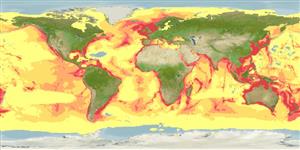Mammalia |
Cetartiodactyla |
Delphinidae
Environment: milieu / climate zone / تغييرات عمق / distribution range
بوم شناسي
سطح زی; اقیانوس رو (مرجع 75906); تغييرات عمق 0 - 1316 m (مرجع 116169). Tropical; 90°N - 90°S, 180°W - 180°E
Atlantic Ocean, Indo-Pacific and Mediterranean and Black Sea. Tropical to temperate.
Length at first maturity / Size / Weight / سن
بلوغ: Lm ?, range 240 - 260 cm Max length : 380 cm TL جنس نر / بدون خواص جنسي; (مرجع 1394); بيشينه وزن گزارش شده: 650.0 kg (مرجع 1394)
توصيف مختصر
ريخت شناسي
This coastal subspecies (Tursiops truncatus geyphyreus) can be distinguished from the nominate offshore subspecies (Tursiops truncatus truncatus) by the following diagnosable cranial features: W-shaped border of the antorbital notch (vs. U-shaped); barely or not visible interparietal bone (vs. clearly visible); cranial vertex from the posterior end of nasals to the nuchal crest is short and rectangular (vs. long and squared); left nasal bone noticeably smaller and more compressed antero-posteriorly than the right (vs. nearly symmetrical); Falciform lateral margin of the ascending process of right premaxilla (vs. straight or slightly concave); lateral margin of the ascending process of the maxillae over the preorbital process is deflected dorsally (vs. flat) (Ref. 128824).
Preyed upon by great white sharks (Ref. 32140). Dolphins are directly caught for use as shark-bait in Sta. Ana and Aparri, Philippines (Ref. 77119). Found primarily in coastal and inshore regions of tropical and temperate waters of the world (Ref. 936) and deeper channels between islands (Ref. 122680). Also inhabits pelagic waters, such as those in the eastern tropical Pacific (Ref. 936). In herds of less than 20 individuals (Ref. 801). Feeds either cooperatively or in solitary. They can obtain prey via 'fish whacking' and steering fish onto mudflats (Ref. 122680). Feeds on fish (Refs. 801, 936) crustaceans, and cephalopods (Ref. 801).
Life cycle and mating behavior
بلوغ | تولید مثل | تخم ریزی | Eggs | Fecundity | Larvae
مآخذ اصلی
مراجع | هماهنگ كننده | همكاران
Tan, J.M.L. 1995 A Field Guide to the Whales and Dolphins in the Philippines. Makati City: Bookmark. 125 p. (مرجع 936)
وضعيت در فهرست قرمز IUCN
(مرجع 130435: Version 2025-1)
وضعيت از نظر سايتس (مرجع 108899)
خطر برای انسان ها
استفاده انسانی
ماهي گيري – شيلات: تجاري; طعمه: usually
FAO - ماهي گيري – شيلات: landings, نمايه گونه | FishSource | Sea Around Us
ابزارها
اطلاعات بيشتر
PhysiologyOxygen consumption
Human RelatedStamps, coins, misc.
منابع اينترنتي
Estimates based on models
Preferred temperature
(Ref.
115969): 6.4 - 28.9, mean 20.3 (based on 16698 cells).
جهندگی
زياد, كمينه زمان لازم براي دو برابر شدن جمعيت ، كمتر از 15 ماه (K=0.14-0.48; tm=8.5).
Fishing Vulnerability
Very high vulnerability (76 of 100).
طبقه قيمت
Unknown.
